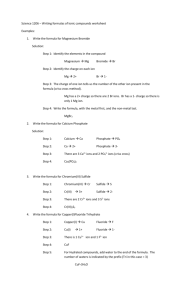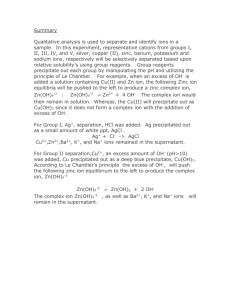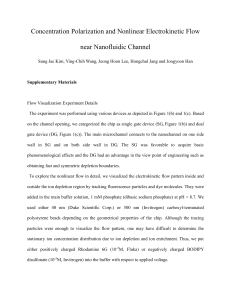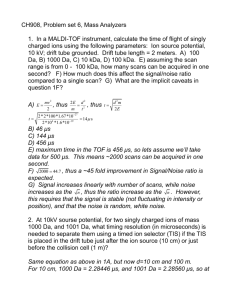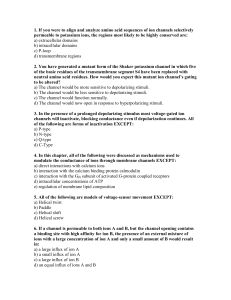Impurities in Natural Water
advertisement
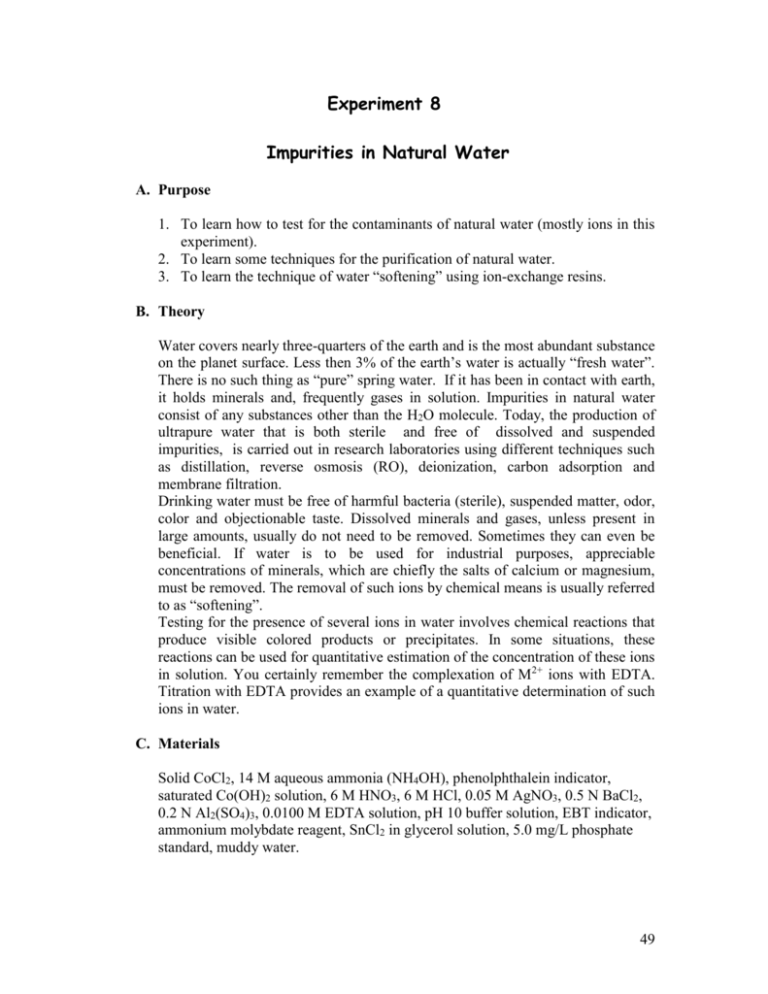
Experiment 8 Impurities in Natural Water A. Purpose 1. To learn how to test for the contaminants of natural water (mostly ions in this experiment). 2. To learn some techniques for the purification of natural water. 3. To learn the technique of water “softening” using ion-exchange resins. B. Theory Water covers nearly three-quarters of the earth and is the most abundant substance on the planet surface. Less then 3% of the earth’s water is actually “fresh water”. There is no such thing as “pure” spring water. If it has been in contact with earth, it holds minerals and, frequently gases in solution. Impurities in natural water consist of any substances other than the H2O molecule. Today, the production of ultrapure water that is both sterile and free of dissolved and suspended impurities, is carried out in research laboratories using different techniques such as distillation, reverse osmosis (RO), deionization, carbon adsorption and membrane filtration. Drinking water must be free of harmful bacteria (sterile), suspended matter, odor, color and objectionable taste. Dissolved minerals and gases, unless present in large amounts, usually do not need to be removed. Sometimes they can even be beneficial. If water is to be used for industrial purposes, appreciable concentrations of minerals, which are chiefly the salts of calcium or magnesium, must be removed. The removal of such ions by chemical means is usually referred to as “softening”. Testing for the presence of several ions in water involves chemical reactions that produce visible colored products or precipitates. In some situations, these reactions can be used for quantitative estimation of the concentration of these ions in solution. You certainly remember the complexation of M2+ ions with EDTA. Titration with EDTA provides an example of a quantitative determination of such ions in water. C. Materials Solid CoCl2, 14 M aqueous ammonia (NH4OH), phenolphthalein indicator, saturated Co(OH)2 solution, 6 M HNO3, 6 M HCl, 0.05 M AgNO3, 0.5 N BaCl2, 0.2 N Al2(SO4)3, 0.0100 M EDTA solution, pH 10 buffer solution, EBT indicator, ammonium molybdate reagent, SnCl2 in glycerol solution, 5.0 mg/L phosphate standard, muddy water. 49 D. Procedure (with Setup and Theoretical Explanations) Purification of water by distillation: Set up the distillation apparatus as shown in Fig. 1. Fig. 1 1. Add 100 mL of water and a few crystals of CoCl2 to the boiler to give the water a slight pink color. Put in a few boiling chips, and distill slowly until about 2 cm of distillate has accumulated in the receiving tube. Note the color of the distillate as compared with the initial mixture. Is the pinkcolored impurity present in the distillate? Save this distillate (label A1) for part B, covering the tube with parafilm paper. 2. Empty the still, rinse it well with distilled water then add 5 mL of concentrated aqueous ammonia, 25 mL of distilled water and distill slowly, using a fresh receiver. Note the odor of the distillate as compared with that of the solution being distilled. Pour a few drops of the distillate into a clean test tube. Add one drop of phenolphthalein indicator. Note the color. Now add one drop of phenolphthalein to the original solution. Compare the color with that of the distillate test. Save the remainder of the distillate (label A2), for part B. Minerals in tap water: Measure about 125 mL of tap water into a beaker and start it boiling gently. When the volume has been reduced to about half, withdraw a 20 mL sample (call it B1) and place it into a large test tube. Boiling away some of the water concentrates ions that may be present in a very small amount of tap water. Continue boiling of the remaining contents of the beaker to dryness. Remove the flame as soon as the water is gone (to avoid cracking of the glass), and save the residue for step 5 below. 3. Calcium and magnesium hardness: Rinse a 50-mL buret with about 10 mL of EDTA solution, mount it vertically in a ring stand, and fill it above the zero mark with EDTA solution. Open the valve and carefully withdraw 50 solution into a waste beaker until the meniscus stands at exactly 0.0 mL. No bubble should remain at the tip. With a buret measure 100.00 mL of tap water to be tested and pour it into a 250-mL Erlenmeyer flask. Add 1 mL of the buffer solution and 10 drops of EBT indicator. Titrate with EDTA solution from the buret with active stirring until the win-red color of the indicator turns blue (remember to prepare a comparison solution, see Exp. 2). You should not add more than 1 drop of excess. The volume of the EDTA solution is read to the nearest 0.01 mL. Calculate the concentration of CaCO3 (in mg CaCO3/L). 4. Chloride ion test: Divide the 20-mL sample of tap water (B1) into two parts and to the first one, add a few drops of HNO3 and 1 mL of AgNO3 solution (provided in a dropping bottle). A precipitate or cloudiness is AgCl, which indicates that Cl ion was present in the sample. Write the equation. Nitric acid, HNO3, need not be included in the equation because it merely serves to prevent a false test. Try the test on water directly from the tap. Then repeat the test on the distillates A1 and A2. Record your conclusions. 5. Sulfate ion test: To the other half of the sample, add a few drops of HCl and about 1 mL of BaCl2 solution. What do you observe? The substance (precipitate or cloudiness) is BaSO4 and indicates that SO 24 ion was present. Write the equation. The HCl need not be included in the equation. Try the test directly on tap water. Then repeat the test on the distillates A1 and A2. Record your conclusions. 6. Phosphate ion test. Transfer 25 mL of a tap water sample to be tested to a clean Erlenmeyer flask or beaker. Note: This test is particularly interesting if done on surface water that becomes green with algae in the summer because of excessive phosphate in the water. Before delivering the water, the beaker or flask should be cleaned with warm water followed by thorough rinsing with laboratory (distilled or deionized) water. Cleaning with soap is not recommended because soaps and detergents often contain phosphate. Add 20 drops of 0.025 M ammonium molybdate solution (provided in a dropping bottle) to the 25-mL water sample, and swirl to mix. Add 2 drops of stannous chloride (10% SnCl2 in glycerol) solution and mix again by thorough swirling. If phosphate is present, a blue color will develop to a maximum intensity in 5 minutes. For the sake of comparison, run the same phosphate test on a “standard” water sample containing 5.0 mg/L of phosphate. The intensity of the blue color is directly related to the concentration of phosphate in the water. How does your water sample compare in phosphate content to the 5.0 mg/L standard? Record on the report sheet. Repeat the same tests on the sea water sample you have collected for today’s experiment. 51 Useful readings: “Phosphate in the Little Miami River” (http://w3.one.net/~jwclymer/lmr.html); “Phosphate Snap Test Kit” (http://webpages.charter.net/kwingerden/erhs/aquarium/infophos.htm) 7. Indication of carbonates: Inspect the solid residue from the evaporation to dryness. It consists for the most part of CaCO3 and MgCO3 produced by the reactions: Ca(HCO3)2 (aq) CaCO3 (s) + H2O (l) + CO2 (g) Mg(HCO3)2 (aq) MgCO3 (s) + H2O (l) + CO2 (g) Put a few drops of HCl solution on the residue and tilt the beaker so as to let it flow slightly. A slight bubbling at the leading edge indicates the carbonate ion CO 32 . A typical equation is: 2 HCl (aq) + CaCO3 (s) H2O (l) + CO2 (g) + CaCl2 (aq) Water softening using ion-exchange resins: 8. Household type (cation-exchange resin in which cations are replaced by Na). Pour 50 mL of tap water from a beaker through a column of single resin (DOWEX 50W-X8) water softener like the model shown in Fig. 2. Fig. 2 By ion exchange, the resin captures all metal ions and releases Na+ ions in their place. Hence the water now contains increased concentrations of sodium salts such as NaCl. A typical equation for this ion exchange process is: Na2R + CaCl2 CaR + 2NaCl In this equation, the symbol “R” represents the negatively charged site of the cation exchange resin. Make the hardness test on resin-softened water. 52 Also make the chloride, sulfate, and phosphate ion tests and record your result. 9. Deionizing type (ion exchange using both cation- and anion-exchange resins). Combinations of ion exchange resins are used in deionizing units. The cation-exchange resin removes all metal ions and replaces them with H ions, and the anion-exchange resign removes negative ions and replaces them with OH ions. The neutralization reaction H + OH H2O follows. Since the total positive charge must equal the total negative charge in solution, all cations and anions are effectively replaced by water molecules. Preparation of deionized water is less expensive than distillation of water due to lower energy requirements. Deionized water is often substituted for distilled water in scientific applications. Obtain a sample of deionized water and test for hardness, chloride ions, sulfate ions, and phosphate ions. Record your results. Useful reading: “Theory of Ion Exchange” http://www.esb.ucp.pt/~bungah/ionex/theoryd.htm 53 E. CHEM 203 Lab Report NAME : _______________________ EXPERIMENT No. : ______________ TITLE : __________________________________ DATE : ________________ Partner : ________________________ Distillation 1. Distillation of a solution containing a dissolved solid (CoCl2) Is CoCl2 impurity present in the distillate? _______________________ Explain from your observations. 2. Distillation of a solution containing a dissolved gas (NH3) Is NH3 impurity present in the distillate? _______________________ Explain from your observations. Minerals in tap water (or other potable water supply) 3. Calcium and magnesium hardness Initial buret reading _________ Final buret reading __________ Volume of EDTA used __________ Hardness of tap water _________________ (include correct concentration units) 4. Chloride ion test Evaporated water ________________ Tap water ________________ Equation for test: _______________________________________________ 5. Sulfate ion test Evaporated water ________________ Tap water ________________ Equation for test: _______________________________________________ 54 6. Phosphate ion test Does tap water produce a blue color? _______________ How does it compare to the 1.0 mg/L standard? ___________________________ 7. Indication of carbonate Is the CO32 ion present in the residue? ____________ How do you know? Write a balanced equation for the reaction of HCl with any MgCO3 that may have been present: Water softening using ion-exchange resins 8. Household type Initial buret reading ___________ Final buret reading ____________ Volume of EDTA used ____________ Hardness of softened water _____________ Is chloride ion present? ____________ Is sulfate ion present? _____________ Is phosphate ion present? 9. Deionizing type Questions 1. What reaction between soil, water and limestone rock accounts for the relatively large amounts of Ca(HCO3)2 and Mg(HCO3)2 found in ground water. Where does the necessary CO2 come from? 2. “Boiler scale” forms in kettles, consisting mainly of calcium carbonate. Write a chemical equation for the corresponding reaction. Explain why the scale forms much more heavily at high temperature (like the boiling point of water). 55
